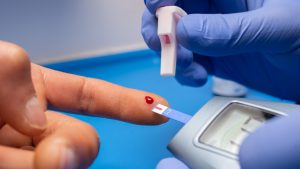Diabetes, a widespread health condition affecting millions globally, is often surrounded by misconceptions regarding its causes and risk factors. In this comprehensive article, we will address and debunk a prevalent myth: the belief that excessive sugar consumption is the primary cause of type 2 diabetes. We’ll delve into the complexities of this misconception, examine the intricate relationship between sugar intake and diabetes risk, and provide evidence-based insights to illuminate this important topic.

Understanding Diabetes
Diabetes encompasses two primary types:
Type 1 Diabetes: This autoimmune condition arises when the immune system attacks insulin-producing beta cells in the pancreas. It is unrelated to dietary factors and cannot be prevented through lifestyle changes.
Type 2 Diabetes: Characterized by insulin resistance or insufficient insulin production, type 2 diabetes is influenced by genetic predisposition, lifestyle choices, and overall health.
The Myth: Sugar Consumption and Diabetes
A widespread belief suggests that consuming excessive amounts of sugar directly causes type 2 diabetes. This misconception has led to the perception that eliminating sugar entirely from one’s diet can prevent or manage diabetes. However, the reality is more nuanced:
Insulin Resistance: Type 2 diabetes is closely associated with insulin resistance, where cells become less responsive to insulin’s actions, and the pancreas may struggle to produce sufficient insulin. Excessive calorie consumption, including sugars, can contribute to weight gain and exacerbate insulin resistance in susceptible individuals.
Additional Risk Factors: Beyond sugar intake, other significant risk factors for type 2 diabetes include genetics, sedentary lifestyle, high consumption of saturated fats, and lack of regular physical activity.
Analysis of Studies and Scientific Evidence
Scientific research provides valuable insights into the relationship between sugar consumption and the risk of type 2 diabetes:
A meta-analysis published in Diabetologia synthesized data from prospective cohort studies and found a modest association between sugar-sweetened beverages and increased type 2 diabetes risk. However, researchers emphasize that this association is weaker compared to more substantial factors such as obesity and overall dietary patterns (Source: Meta-analysis in Diabetologia).
Longitudinal studies, including research published in the American Journal of Clinical Nutrition, highlight the broader impact of dietary quality and total caloric intake on diabetes risk, suggesting that a balanced diet is crucial in diabetes prevention (Source: Study in AJCN).
Education and Prevention Strategies
Educational efforts focused on promoting a balanced, nutritious diet and encouraging regular physical activity are pivotal in preventing type 2 diabetes:
Balanced Diet: Emphasize the consumption of whole grains, fruits, vegetables, lean proteins, and healthy fats while limiting added sugars and processed foods.
Physical Activity: Engage in regular exercise to improve insulin sensitivity, manage weight, and support overall health.
Regular Health Monitoring: Routine medical check-ups to assess diabetes risk factors and monitor blood glucose levels as needed.
Resources and Further Reading
Explore more about diabetes, sugar consumption, and related topics through reputable publications and research:
- American Diabetes Association
- Centers for Disease Control and Prevention – Diabetes
- National Institute of Diabetes and Digestive and Kidney Diseases
Conclusion
Dispelling the myth that type 2 diabetes is solely caused by excessive sugar consumption is crucial for promoting accurate understanding and effective preventive strategies. While moderating sugar intake can be beneficial for overall health, type 2 diabetes is a multifactorial condition influenced by various genetic, lifestyle, and environmental factors. By adopting a holistic approach to health, including a balanced diet, regular physical activity, and ongoing health monitoring, individuals can significantly reduce their risk of developing diabetes and improve their overall well-being.
This article aims to provide evidence-based insights to clarify misconceptions and empower individuals to make informed decisions about their health. For more in-depth information on managing diabetes risk factors and adopting healthy lifestyle practices, we encourage further exploration of the provided resources and consultation with healthcare professionals.
E4 Helps you:
At E4, we’re dedicated to revolutionizing how people manage type 2 diabetes through our innovative E4 Alive program. Our team of specialists has joined forces to create a comprehensive solution aimed at empowering individuals to take charge of their health journey. With personalized support and resources tailored to each person’s unique needs, we make managing diabetes simpler and more effective than ever before.
E4 Alive offers a range of tools and resources to help you better understand and control your blood sugar levels. Our program provides personalized guidance to create a healthy eating plan and integrate regular physical activity into your daily routine. Plus, you’ll have access to a supportive community of individuals who understand your challenges and are there to offer encouragement and guidance every step of the way.
By joining E4 Alive, you can effectively manage your blood glucose levels, improve long-term glycemic control, reduce your risk of diabetes-related complications, and enhance your overall quality of life. It’s not just a program; it’s an opportunity to reclaim your health and vitality. Ready to start your journey to better health? Visit THIS PAGE to learn more about E4 Diabetes Solutions and the E4 Alive program.
To learn more about E4 Diabetes Solutions and the E4 Alive program, visit THIS PAGE.

Type 2 Diabetes: Is It Really Reversible?
A recent National Geographic article [link] explores how type 2 diabetes could be reversible with the right approaches. This condition, which affects millions of people worldwide, has long been considered a chronic and progressive disease. However, recent research challenges this perception and suggests that with lifestyle changes and the right approach, remission is possible. The

How Do GLP-1 Drugs Compare? A Breakdown of Ozempic, Mounjaro, and Trulicity
GLP-1 receptor agonists have revolutionized diabetes management, with drugs like Ozempic, Mounjaro, and Trulicity leading the market. But how do these medications compare in terms of effectiveness, side effects, and patient outcomes? Let’s explore their differences and what they mean for diabetes patients. Understanding GLP-1 Medications GLP-1 receptor agonists mimic a natural hormone that helps

Why Has Medicare Spending on Diabetes Medications Skyrocketed in 5 Years?
In the past five years, Medicare spending on diabetes medications has increased nearly fivefold, reaching $35.8 billion in 2023. This surge has been primarily driven by the growing use of GLP-1 drugs such as Ozempic, Mounjaro, and Trulicity. But what is behind this cost escalation, and how does it affect patients and the U.S. healthcare

The Gut Microbiota and Blood Sugar Control: A Hidden Connection
The human gut is home to trillions of bacteria that play a crucial role in digestion, immune function, and even metabolism. Recent research has revealed a fascinating link between the gut microbiota and blood sugar regulation, shedding light on how the balance of microbes in our intestines can influence diabetes risk and overall metabolic health.

The Dawn Phenomenon: Why Blood Sugar Rises While You Sleep
For many people with diabetes, waking up with high blood sugar levels can be frustrating—especially if they didn’t eat anything overnight. This early-morning spike in blood glucose is known as the Dawn Phenomenon, and it happens due to natural hormonal changes in the body. But why does it occur, and how can it be managed?

The Influence of Red Light on Blood: Can It Improve Diabetes?
Type 2 diabetes is a metabolic disease characterized by insulin resistance and elevated blood glucose levels. In the search for complementary alternatives to improve glycemic control, red light therapy has gained attention due to its potential to enhance circulation, reduce inflammation, and optimize cellular function. But what does science say about it? ✨ What is

